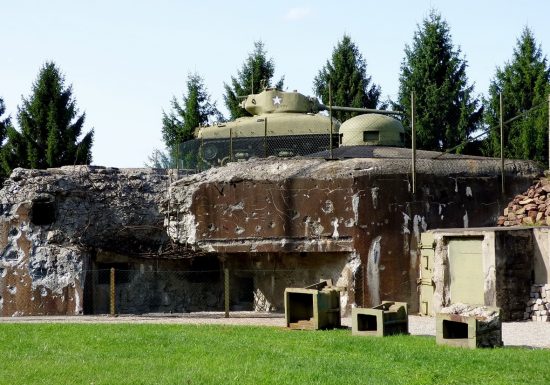
Introduction
The Schoenenbourg Maginot Line Fort, situated in northeastern France, stands as a remarkable testament to military engineering and defensive strategy. Nestled within the dense forests of the Vosges Mountains, this fortification played a pivotal role in France’s defensive line during the early 20th century.
Historical Background of the Maginot Line
Constructed in the aftermath of World War I, the Maginot Line was envisioned as a formidable barrier against potential German aggression. Named after André Maginot, the French Minister of War, this complex network of forts, bunkers, and artillery emplacements stretched along the French-German border.
Construction and Purpose of Schoenenbourg Fort
Completed in 1930, Schoenenbourg Fort was one of the most strategically significant installations along the Maginot Line. Its primary purpose was to deter any incursions from the east and safeguard the Alsace region, which had been repeatedly contested between France and Germany.
Key Features and Design of Schoenenbourg Fort
The fort boasted state-of-the-art defenses, including retractable turrets, armored cupolas, and underground barracks. Its innovative design incorporated layers of concrete and steel, rendering it impervious to most conventional artillery shells and aerial bombardments.
Life Inside Schoenenbourg Fort
Occupied by a garrison of over 700 soldiers during peacetime, Schoenenbourg Fort was equipped with essential amenities such as kitchens, infirmaries, and living quarters. Despite its formidable appearance, life within the fort was marked by monotony and routine patrols along the perimeter.
Role During World War II
During the early stages of World War II, Schoenenbourg Fort faced the full force of the German Blitzkrieg. Despite valiant resistance, the fort’s isolated position and lack of air support ultimately led to its surrender in June 1940.
Post-World War II Era
Following the war, Schoenenbourg Fort was partially demilitarized and relegated to secondary roles within France’s defense strategy. Despite periodic upgrades, its significance waned in the face of evolving military doctrines and technologies.
Preservation Efforts and Tourism
In recent decades, efforts have been made to preserve Schoenenbourg Fort as a testament to France’s military heritage. Today, it stands as a popular tourist attraction, offering guided tours and immersive experiences that showcase its historical significance.
Schoenenbourg Fort: A Symbol of Defensive Strategy
Beyond its military importance, Schoenenbourg Fort symbolizes the resilience and ingenuity of the French people in the face of adversity. Its enduring presence serves as a reminder of the sacrifices made to secure the nation’s sovereignty.
Visiting Schoenenbourg Fort Today
For visitors, Schoenenbourg Fort offers a fascinating glimpse into the past. Guided tours explore the labyrinthine tunnels, artillery emplacements, and living quarters, providing insight into the daily lives of its defenders.
Exploring the Tunnels and Bunkers
One of the highlights of a visit to Schoenenbourg Fort is the opportunity to explore its intricate network of tunnels and bunkers. Visitors can marvel at the engineering prowess that went into constructing these underground passages, which once buzzed with activity during times of conflict.
Educational Significance of Schoenenbourg Fort
Beyond its tourism appeal, Schoenenbourg Fort serves as an educational resource, offering insights into military history, strategy, and technology. School groups and enthusiasts alike can delve into the intricacies of fortress warfare and the evolving nature of defensive architecture.
Military Innovations and Lessons Learned
The legacy of Schoenenbourg Fort extends beyond its physical structure. It stands as a testament to military innovation and the ongoing quest for strategic superiority. Lessons learned from its construction and defense continue to inform contemporary military doctrines.
Legacy of Schoenenbourg Maginot Line Fort
As a symbol of France’s determination to defend its borders, Schoenenbourg Fort holds a special place in the nation’s collective memory. Its enduring legacy serves as a reminder of the sacrifices made in the pursuit of peace and security. Nestled within the serene landscapes of northeastern France lies the formidable Schoenenbourg Maginot Line Fort. This historical treasure stands as a testament to the ingenuity and strategic prowess of its creators. In this comprehensive guide, we embark on a journey to explore the depths of this iconic fortress, delving into its rich history, architectural wonders, and enduring legacy.
Exploring the Surrounding Landscape:
Venture beyond the confines of Schoenenbourg Maginot Line Fort and discover the captivating attractions that adorn its surroundings. From quaint villages to picturesque landscapes, the Alsace region offers a plethora of experiences to enrich your journey.Beyond the confines of the Schoenenbourg Maginot Line Fort lies a landscape steeped in beauty and intrigue. The Alsace region, with its rolling hills and charming villages, offers a myriad of experiences for visitors to enjoy. Whether you’re interested in exploring historical landmarks, sampling local cuisine, or simply taking in the scenic vistas, there’s something for everyone to discover.
Preserving History for Future Generations:
As we reflect on the significance of the Schoenenbourg Maginot Line Fort, it becomes evident that its preservation is paramount. Efforts to conserve this historical gem are ongoing, with dedicated individuals and organizations working tirelessly to ensure its legacy endures. By supporting these preservation initiatives, we can ensure that future generations have the opportunity to experience the wonder of this architectural marvel.
History and Construction
Origins of the Maginot Line
The Maginot Line, named after André Maginot, the French Minister of War, was conceived in the aftermath of World War I as a defensive barrier against potential German aggression. Stretching along the French-German border, this complex network of forts, bunkers, and underground galleries aimed to safeguard France from invasion.
Purpose and Design of Schoenenbourg Fort
Constructed between 1929 and 1935, Schoenenbourg Fort was one of the key components of the Maginot Line. Situated near the village of Schoenenbourg in the Alsace region, this fortress was strategically positioned to defend the vital plains of Alsace and the city of Strasbourg.

Features and Layout
Underground Bunkers
One of the most distinctive features of Schoenenbourg Fort is its extensive network of underground bunkers and galleries. These subterranean passages, equipped with living quarters, ammunition depots, and communication facilities, allowed the garrison to withstand prolonged sieges.
Armament and Defensive Measures
Armed to the teeth, Schoenenbourg Fort boasted a formidable array of weaponry, including artillery pieces, machine guns, and anti-tank guns. In addition to its firepower, the fortress was protected by a series of obstacles such as barbed wire entanglements and anti-tank ditches.
Life in Schoenenbourg Fort
Daily Routine
Life within Schoenenbourg Fort followed a strict regimen dictated by military discipline. Soldiers were assigned various duties, ranging from sentry duty to maintenance tasks, ensuring the smooth operation of the fortress.
Living Conditions
Despite the austere surroundings, efforts were made to provide basic amenities for the garrison. Barracks were equipped with heating systems, electricity, and rudimentary sanitation facilities to mitigate the harsh realities of underground living.
Role in World War II
Defense Strategy
As tensions escalated in Europe leading up to World War II, Schoenenbourg Fort was placed on high alert, ready to repel any incursions by German forces. However, the impregnability of the Maginot Line was put to the test when German forces bypassed it by invading through Belgium in May 1940.
Combat Engagements
During the Battle of France, Schoenenbourg Fort saw limited action as German forces focused their efforts on bypassing the Maginot Line rather than engaging it directly. Despite sporadic skirmishes, the fortress held its ground, serving as a symbol of French resistance.
Legacy and Tourism
Preservation Efforts
In the post-war years, Schoenenbourg Fort underwent extensive restoration efforts to preserve its historical significance. Today, it stands as a testament to the resilience of the French people and serves as a poignant reminder of the futility of war.
Visitor Experience
Visitors to Fort can embark on guided tours that offer a glimpse into the daily lives of the soldiers who once manned its ramparts. From exploring the underground bunkers to marveling at the panoramic vSchoenenbourgiews from its observation posts, the fortress provides a captivating journey through history.
History of the Maginot Line
The Maginot Line, named after French Minister of War André Maginot, was conceived in the aftermath of World War I as a defensive barrier against potential German aggression. Stretching along the French-German border, it aimed to safeguard France from a repeat of the devastating trench warfare that characterized the Great War.
Creation and Purpose
Constructed between the 1920s and 1930s, the Maginot Line comprised a network of fortifications, bunkers, and obstacles fortified with state-of-the-art weaponry and defensive mechanisms. Its primary objective was to deter any incursion into French territory and provide a secure base for launching counteroffensives if necessary.
Construction of Schoenenbourg Fort
Among the numerous forts that constituted the Maginot Line, Schoenenbourg stood out for its strategic location and formidable defenses. Built between 1929 and 1935, it exemplified the pinnacle of military engineering of its time, boasting an intricate system of underground tunnels and armaments.
Strategic Importance of Schoenenbourg Fort
Schoenenbourg Fort occupied a pivotal position within the Maginot Line, guarding the Alsace region and serving as a key stronghold against potential German advances. Positioned atop a hill overlooking the surrounding countryside, it provided a commanding view of the terrain, enabling effective surveillance and defensive operations.
Features and Architecture of Schoenenbourg Fort
Underground Facilities
Beneath its imposing surface, Schoenenbourg Fort housed an extensive network of tunnels, barracks, and storage facilities designed to sustain prolonged periods of siege. Equipped with living quarters, kitchens, and medical facilities, it offered a semblance of comfort amidst the rigors of military life.
Defensive Installations
The surface of Schoenenbourg Fort bristled with a formidable array of weaponry, including artillery pieces, machine gun emplacements, and anti-tank obstacles. These defenses were strategically positioned to cover all approaches and repel any enemy assault with devastating firepower.
Life Inside Schoenenbourg Fort
Life within the confines of Schoenenbourg Fort was characterized by strict discipline and rigorous training. Soldiers adhered to a daily routine of patrols, drills, and maintenance tasks, ensuring the readiness of the fortification to repel any threat.
Daily Routine of Soldiers
Soldiers stationed at Schoenenbourg Fort followed a meticulous schedule, alternating between periods of guard duty, rest, and training exercises. Despite the monotony of military life, camaraderie flourished among the men, forged through shared experiences and mutual dependence.
Challenges and Conditions
The harsh realities of life within a military fortress were compounded by the cramped living quarters and limited amenities. Rations were sparse, and conditions could be claustrophobic, particularly during extended periods of confinement within the underground bunkers.
Conclusion
In conclusion, the Schoenenbourg Maginot Line Fort stands as a beacon of resilience and human ingenuity, showcasing the remarkable feats achieved in the name of defense. From its imposing architecture to its enduring legacy, this fortress continues to captivate visitors with its tales of valor and sacrifice.As you delve into the depths of the Schoenenbourg Maginot Line Fort, you’ll find yourself immersed in a world of history, innovation, and strategic brilliance. From its inception to the present day, this fortress has stood as a bastion of defense, safeguarding France’s borders and preserving its legacy for generations to come.

